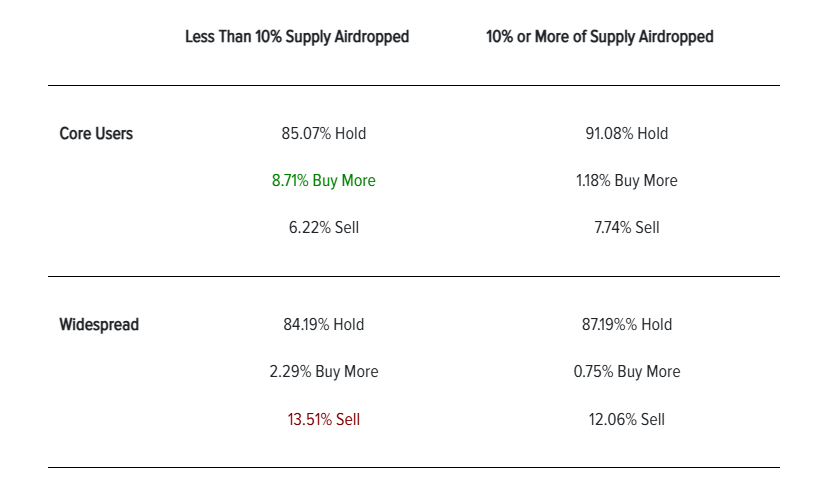Airdrops are the most overused, misunderstood, and poorly executed tactic in Web3.
Every founder’s heard the “playbook”:
Drop tokens to as many wallets as possible. Create hype. Reward early users. Bootstrap governance. Watch your community grow overnight.
The reality? Most airdrops are nothing more than a massive liquidity event for people who don’t care about your product.
We’ve been digging into fresh 2024 research covering 40 protocols, 2M+ wallets, and the results are brutal for anyone clinging to the old playbook.
The Targeting Myth
The biggest mistake? Believing “more wallets = more adoption.”
When protocols airdropped to widespread audiences (people who’d never used the product but had done vaguely similar on-chain stuff), recipients were 2x more likely to sell than core users.
Why? Because free money is free money. If I’ve never touched your protocol before, your token is just another asset to dump.
On the flip side, small airdrops to core users, the people already engaging with your product, saw 4-8x more buyers post-drop. These users didn’t just hold; they increased their positions. That’s conviction.
The takeaway:
If you want an airdrop to create momentum instead of a sell wall, stop chasing tourists and reward the believers.

The Size Illusion
Crypto Twitter loves to argue about “how big the drop should be.” 5%? 10%? 20%?
The data says… it doesn’t really matter.
Across the board, token prices dropped 10-40% within 60 days of TGE, regardless of whether the allocation was large or small.
The worst offenders? Large + Widespread drops. Big supply hitting the market + no product attachment = instant volatility and sustained underperformance.
The “low float” theory also takes a hit here. You can airdrop 5% or 60%, if you give tokens to the wrong hands, you’ll still tank.

Price Performance Reality Check
Here’s the cold truth:
- Only 10 of 40 airdropped tokens were worth more after two months than they were 24 hours after launch.
- Core-user drops consistently outperformed on both price stability and volatility.
- Airdrop size alone had zero statistically meaningful impact on performance.
Translation: If your airdrop is relying on optics like “scarcity” or “shock value,” you’re already setting yourself up for disappointment.

The Post-Drop Problem
Too many teams treat the airdrop as the endgame. They plan for months, execute the drop, and then… go quiet.
What happens? Engagement collapses. Recipients dump. New liquidity dries up.
The protocols that actually retained value did something different:
- Rolled out meaningful product updates within weeks of the drop.
- Tied tokens to staking, governance, or feature unlocks.
- Managed unlock schedules to avoid follow-up sell pressure spikes.
If your post-airdrop plan is just “hope number go up,” you’re already dead.
Designing an Airdrop Like It’s Capital Allocation
Here’s the part most people miss: an airdrop is not a marketing gimmick, it’s a treasury allocation decision worth millions.
That means you need to think about it like deploying capital:
- Know your objective. Are you rewarding early contributors? Distributing governance? Bootstrapping liquidity? The “who” changes depending on the “why.”
- Segment your audience. Not all core users are equal. Reward those who bring liquidity, governance activity, or high-value transactions.
- Create retention hooks. The best airdrops force recipients to stay engaged, staking boosts, governance weight multipliers, or in-protocol perks.
- Keep powder dry. Big drops feel exciting in the moment, but they drain your ability to incentivize future growth.
What Founders Should Actually Do
From working with early-stage projects across AI, DeFi, DePIN, and infrastructure, here’s our blunt advice:
- Target conviction, not reach. Your airdrop list should look like your most active analytics dashboard, not a list of wallets scraped from similar protocols.
- Stop obsessing over % supply. Size doesn’t matter if alignment is wrong.
- Make it part of the product journey. The claim process should naturally lead into using your protocol, not just claiming and leaving.
- Measure beyond price. Wallet retention, governance participation, and liquidity depth are better indicators of success than 24-hour candles.
Why Most Founders Will Still Get It Wrong
Because doing it right isn’t sexy.
It’s easier to say “we hit 100,000 airdrop recipients” than “we converted 1,000 power users into long-term governance participants.” The first sounds good in headlines; the second actually builds a sustainable protocol.
The bad news: the market punishes hype-driven airdrops brutally.
The good news: the data-backed playbook for success is clear, and very few are running it.
Where ChainGPT Labs Comes In
We don’t just look at the surface-level “success metrics” that Twitter loves. We dig into wallet flows, liquidity dynamics, governance engagement, and the tokenomics decisions that drive real outcomes.
If you’re building in AI, DeFi, DePIN, or blockchain infrastructure:
COMPARISON
Image


.png)

.png)







